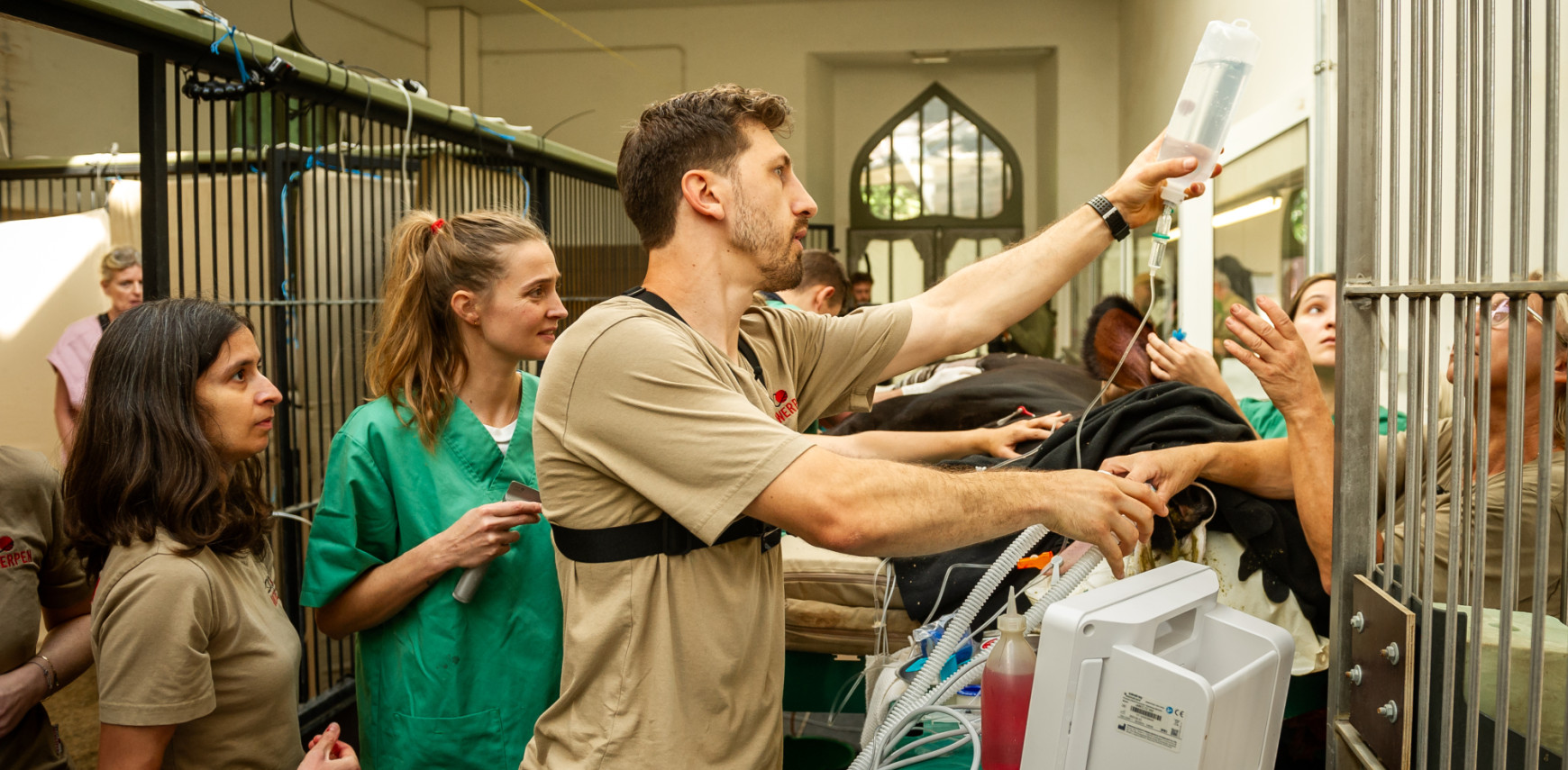A ‘first’ at Antwerp ZOO: Never before performed knee surgery provides an okapi with a pain-free future
Antwerp ZOO’s smallest okapi is once again putting his best foot forward after a serious knee operation. The operation was an absolute first, as this surgical procedure has never been applied to an okapi before. The animal suffered from knee problems ever since it was born, which would have a negative impact on its mobility and general quality of life in the long term. Thanks to the recent surgery, in which tiny incisions were made on the ligaments of its kneecap, the youngest member of the okapi group is now taking careful steps towards a full recovery.
Not long after Xambo was born in October 2022, it became clear that the okapi foal was suffering from considerable problems in his hind legs. Due to a defect in his knee joints, both of Xambo’s kneecaps frequently became locked, causing him to walk with stiff, rigidly outstretched legs. ‘In veterinary medicine, we call this a patellar fixation’, explains veterinarian Jonas Spruyt. ‘In an animal with this condition, the kneecap is occasionally dislocated, which leads to locked knees that can cause serious pain and inflammation. If this occurs frequently, it can have a long-term impact on the stability of the knee and may even lead to osteoarthritis.’ Although this is the first time that patellar fixation was observed in an okapi, this condition is not exceptional among other animal species. Horses as well as bovine animals can suffer from this affliction, which can be cured successfully through a specific surgical procedure. To ensure a pain-free future and normal mobility for Xambo, surgery was the only – and carefully considered – option.
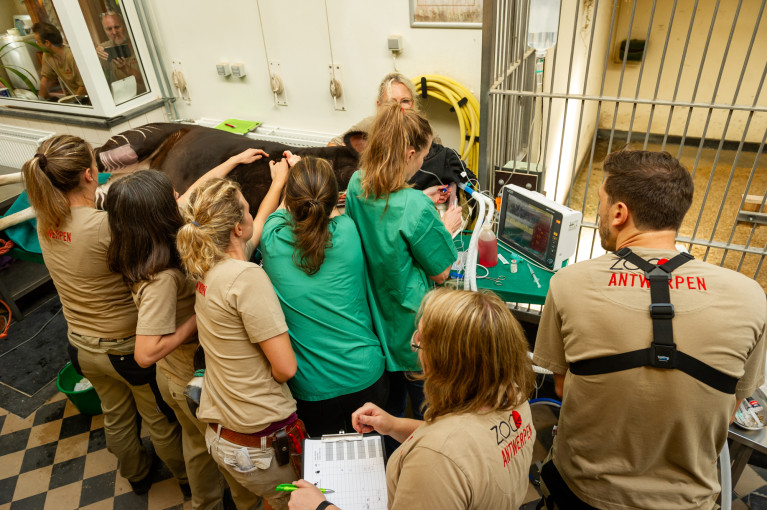
Teaming up
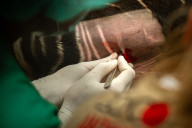
Antwerp ZOO teamed up with the Faculty of Veterinary Medicine of Ghent University for this project. As a renowned expert in the field of okapis and the species’ international studbook keeper, Antwerp ZOO has far-reaching expertise on board when it comes to caring for these endangered animals. The veterinary surgeons of Ghent University, on the other hand, have an impressive track record in the application of surgical procedures for knee problems in horses and bovine animals. Pooling the expertise of both organisations led to a unique approach in curing the okapi’s patellar fixation. "It's the very first time ever that this technique is being applied to an okapi," says veterinarian Jonas. "The surgeon made small incisions on the patellar ligaments, causing them to inflame. This inflammation causes the patellar ligaments to thicken and contract, stabilizing the knee."
"The surgeon made small incisions on the patellar ligaments, causing them to inflame. This inflammation causes the patellar ligaments to thicken and contract, stabilizing the knee." - Veterinary Jonas Spruyt, Antwerp ZOO
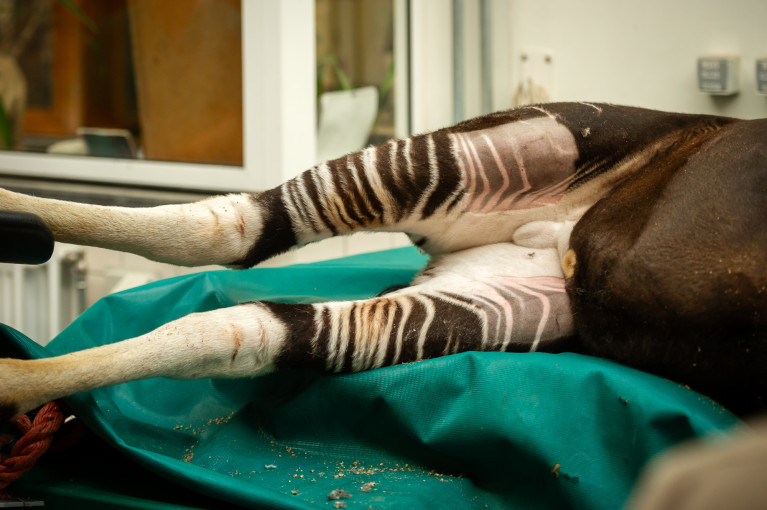
Professor Dr Lieven Vlaeminck, who generally operates on horses and cows, underscores that the chosen technique was an excellent choice considering the anatomical similarities between okapis, horses and bovines. ‘The cause of the okapi’s locked knee is identical to a condition we are familiar with in other animals. The biggest difference concerned the thickness of the skin. During the operation, I noticed was that an okapi’s skin is a lot thicker than that of a horse.’ The operation also presented the professor – who generally sees only horses and cows on his operating table – with a unique opportunity. ‘Performing this surgery on an okapi was an exceptional opportunity indeed,’ said Vlaeminck. ‘When the zoo approached me for this, I did not hesitate for a second.’
"‘When the zoo approached me for this, I did not hesitate for a second.’" - Professor Dr Lieven Vlaeminck, UGent
Course of the operation
Just as in any surgical procedure, there were risks involved. When the animal involved is as sensitive as the okapi, it’s important to take potential complications in relation to anaesthetics into account. A complication that the team was particularly keen to prevent is called ileus, a paralysis of the intestinal system that can lead to an ultimately lethal disruption to the bowel movements. Therefore, precision was paramount in administering the anaesthetic, as well as closely monitoring every development. Fortunately, the team could depend on the extensive expertise of the veterinarian for the success of this part of operation.
‘Because the surgeon would be operating on an anatomically delicate spot, it was of crucial importance that the animal was quickly put into a deep sleep. The anaesthesia, however, did not run as smoothly as anticipated, and Xambo briefly stopped breathing. By responding quickly and applying artificial respiration his condition quickly stabilised.’ Thanks to careful preparation and outstanding teamwork, the surgery proceeded meticulously from that point onwards. An hour after the start of the surgery Xambo was standing on all four legs in his stable. Although the long-term results of the surgery cannot be ascertained yet, everything points to a promising recovery.
Taking expertise to a higher level
Antwerp ZOO has been the international studbook holder of the endangered okapi ever since 1977, and has been studying this species ever since the first okapi from Buta (Congo) arrived here in 1919. This unique and extensively documented surgery also contributes to valuable scientific research, and is the subject of a scientific publication currently being prepared: ‘Surgical Splitting for Patella Fixation in Okapis’. This newly acquired knowledge will, of course, be shared with other zoos. ‘This will help us take scientific knowledge about the okapi to a higher level,’ says veterinarian Jonas Spruyt. Professor Vlaeminck hopes that this first-time operation will also contribute to helping other zoo animals with a similar condition elsewhere in the world.
Every animal counts
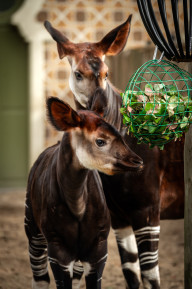
The okapi is a seriously endangered species. Wild game hunting and deforestation are a threat to these animals’ chances of survival, and the reason why the okapi population is dwindling year after year. With only 82 okapis currently housed in European zoos, the okapi can certainly be called a rare animal. Each individual animal is of inestimable value, which once again underscores the importance of safeguarding Xambo’s future through surgery.
In 1985, Antwerp ZOO became the coordinator of a breeding programme for okapis, with the noble goal of increasing the worldwide okapi population in zoos to 230 animals. This specific number is necessary to safeguard the generic diversity of the species and ensure the availability of enough okapis to release back into the wild, should this be necessary.

